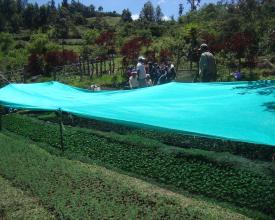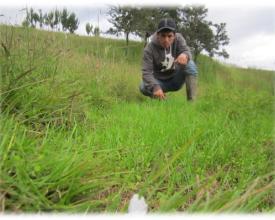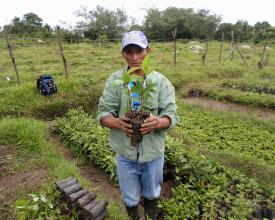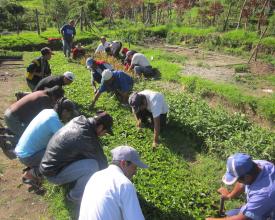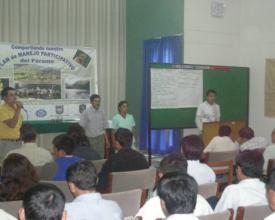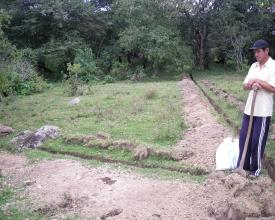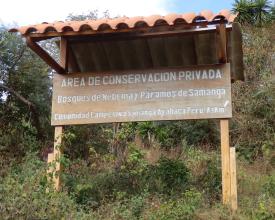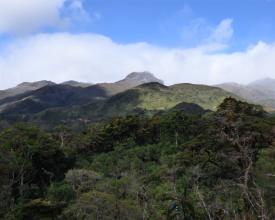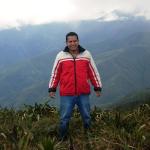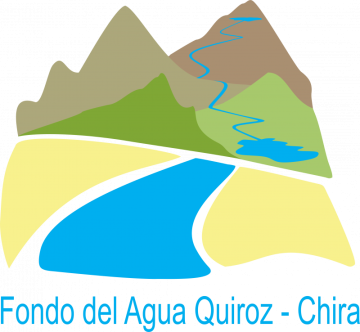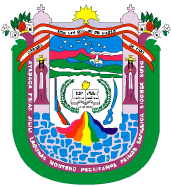
Conservation of moorlands and high Andean forests to recover water regulation in the basin.
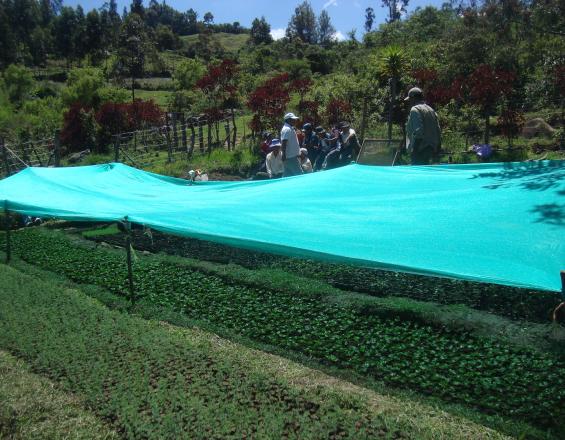
Climate change scenarios in the Piura Region predict a shortage of water supply, which will affect the population both in the upper part (community) and in the lower part of the basin (irrigation water users). The solution contributes to improving resilience through conservation actions in the cloud forests and moorlands (mountain ecosystems efficient in water retention) in the Samanga Community, for which it has a Conservation Area "Bosques de Neblina y Páramos de Samanga" and its respective Participative Management Plan. Likewise, the adaptive capacity has been improved through agreements between the community and the users-irrigators, which contribute to the sustainability of conservation actions (including capacity building and sustainable development). The aim is to recover and maintain the water regulation service of the Quiroz River basin, especially the water supply in the lower part.
Context
Challenges addressed
The main challenge is the risk to water availability and supply in the agricultural valley of the Quiroz river basin, due to the fragmentation and degradation of the ecosystems in the headwaters of the basin, mainly moorlands and cloud forests, which have reduced natural coverage by 30% (analysis of satellite images 2001).
The cloud forests and paramos are threatened by increased migratory agriculture, overgrazing, afforestation of a non-forested ecosystem, logging and burning of the natural forest, and possible mining, in addition to the potential dangers of climate change.
The population of the Samanga community lives in conditions of poverty, whose agricultural activities only allow them to survive and a minimal percentage to sell and thus buy basic necessities.
Location
Process
Summary of the process
The development of the Participative Management Plan for the moorlands of the Samanga Campesino Community (BB2) allowed the population to define actions for the conservation and sustainable use of the moorlands, monitoring their own progress. This space for discussion and reflection facilitated the identification and development of the Mechanism of retribution for ecosystem services: Quiroz-Chira Water Fund (BB1) and the Bosques de Neblina y Páramos de Samanga Private Conservation Area (BB3).
Building Blocks
Compensation mechanism for ecosystem services: Quiroz-Chira Water Fund
The mechanism of retribution for ecosystem services Quiroz-Chira Water Fund (FAQCH) has been created with the purpose of channeling economic resources from the users of the lower basin of the Quiroz, Macará and Chira system to implement conservation and sustainable development actions in the upper basin, being the community of Samanga one of the beneficiaries of the Fund since 2014.
For this, the community must annually prioritize up to two activities and develop a proposal that is reviewed and approved by the FAQCH, for which an agreement is signed with the community for the implementation of the proposal.
The FAQCH brings together five public institutions (municipalities of Ayabaca and Pacaipampa), irrigation boards (San Lorenzo and Chira) and NGOs (Naturaleza y Cultura Internacional), who contribute on an ongoing basis, in cash or in value, to finance the proposals from the communities of the upper watershed. The good governance characteristics of the fund give it the confidence of its members (participatory, transparent and accountable). This process has matured with the support of public and private organizations and successive cooperation contributions, and is now in a scaling-up phase.
Enabling factors
- Conditions of trust and transparency between all stakeholders: upper and lower basin.
- Clear rules from the beginning for beneficiaries.
- Formal agreements for the implementation of activities and conservation.
- Long-term commitments by all involved.
- Continuous monitoring and evaluation of activities.
Lesson learned
- It is possible to obtain the commitment of the actors directly involved (in water use) to finance conservation and development actions.
- It is necessary to include in the proposal support for sustainable economic activities that ensure improved livelihoods for the population implementing the measures.
- It is preferable to channel the use of economic resources to implement concrete actions and not to establish agreements for direct 'payment' for conservation because in time these can become a vicious circle or even a reason for blackmail (e.g. "if they don't pay me I don't conserve").
- The evidence and interaction between beneficiaries and contributors of ecosystem services are favorable for maintaining the best relationships and commitments among all those involved.
- It is important to maintain the financing of the Quiroz water fund to sustain actions in the long term.
Participatory Management Plan for the Community Moorlands
The Andean Páramo Project (PPA), executed between 2006 and 2012 and financed by the Global Environment Facility (GEF), facilitated the construction of the Participatory Management Plan for the conservation and sustainable use of the Páramo. First, the community was approached and trust was established, then a participatory diagnosis was developed to obtain information not only about the páramo, but also about the local population's knowledge and perceptions about it. Also, spaces for discussion and reflection were generated, inviting community members who make direct and indirect use of the páramo. The interaction between the facilitation team and the villagers, through workshops, allowed knowledge sharing and mutual learning. Finally, the Community presented its Plan to the local and regional authorities, assuming the monitoring of the same, to follow up on the conservation status of its moors, the dynamics of land use, as well as some indicators related to their quality of life.
Enabling factors
Required:
- A highly participatory and reflective process.
- Commitment of the community and the institutions in charge of the project.
- Implementation of conservation and productive activities.
Lesson learned
- The development of the participatory management plan has been a long process, but with a lot of involvement and participation of the local population.
- The commitment of all stakeholders involved, mainly the community and the provincial municipality of Ayabaca, to support the implementation of the management plan.
- The permanence of the institutions in the area for a long period of time to accompany and support the implementation of the management plan and the management of other initiatives.
Delimitation and Management of the Bosques de Neblina and Páramos Private Conservation Area
The Samanga Community has delimited part of its territory as a private conservation area. The recognition of a conservation area, through a Ministerial Resolution signed by the Ministry of Environment, is a modality to ensure the protection and sustainable use of natural resources and the services provided by the cloud forest and moorlands for the direct benefit of the Samanga community, and indirectly to all users of the middle and lower watershed. Thanks to the ACP, small projects have been managed to implement sustainable productive activities (to reduce the negative impacts on the forest and paramo) and to signpost the conservation area, which is now delimited on the ground and signposted. In addition, agreements have been reached in community assemblies to sanction people who cause damage or threaten the ACP.
Enabling factors
- Community leadership and organization for the fulfillment of agreements.
- Commitment by the community to conserve the high Andean moorlands and forests.
- Continued patrolling and establishment of sanctions to punish actions that threaten the conservation of the PCA.
- Implementation of conservation and sustainable development activities.
- Conservation agreements should be accompanied by sustainable alternatives that generate wellbeing and income for local families.
Lesson learned
- The community of Samanga had made communal agreements to control logging, burning and overgrazing in the forest and páramo (since 2000). This local interest and demand for conservation has been strengthened and formalized through the recognition of their private conservation area with a resolution from the Ministry of Environment (in 2013).
- The ACP has meant a development opportunity for the community of Samanga, with ongoing projects in dairy products, reforestation, research on the ecosystem services of the forest and páramo, and a tourism proposal, among the main ones.
- The support and accompaniment of local institutions is necessary to support the community in the management of the conservation area and in the generation of alternative proposals.
Impacts
- The community and water users in the lower part of the basin recognize the contribution of the páramo and cloud forest ecosystem to water regulation and actively contribute to the conservation of the private conservation area "Bosques de Neblina y Páramos de Samanga" (ACP).
- Trust has been generated between the parties growing the stability of the system (water users in the lower part and the community in the upper part).
- This community is part of the hydrological monitoring system of the páramo in the Piura region, having preliminarily identified an improvement in the base flow in the intervened basin.
- Pressures on the cloud forest and paramo ecosystems have been reduced and 30 ha of degraded areas have been restored.
- Local and regional governments have found in the Quiroz Chira Water Fund (FAQCH) an opportunity to co-finance conservation and development activities in the villages at the headwaters of the Quiroz River basin.
- The community of Samanga effectively protects its cloud forests and moorlands, for which they have approved community assembly agreements to sanction any activity that causes damage to the ecosystem within the ACP.
- The area has been demarcated and marked. It also has a participatory management plan as a tool for managing the moorland and forest ecosystems from the people themselves.
Beneficiaries
Direct beneficiaries: Families of the farming community of Samanga, Ayabaca (approx. 1700 people).
Indirect: Peasant communities, farmers in the lower watershed and residents of the coastal towns (beneficiaries of ecosystem services).
Sustainable Development Goals
Story
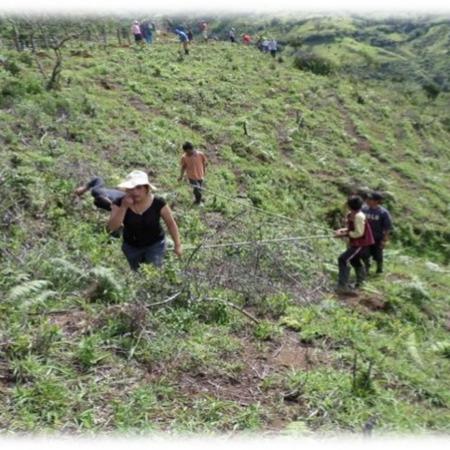
The measure began with the project "Conservation of Diversity in the Paramos of the Northern and Central Andes", known as the Andean Paramo Project (PPA), executed between 2006 and 2012 and financed by the Global Environment Facility (GEF). The actions developed in the 13 pilot sites were carried out so that the páramos would continue to provide their characteristic environmental services, and at the same time to improve the quality of life of the communities that inhabit them, promoting social change.
Through the PPA, the capacities and organizational level of the community were strengthened for the conservation of the páramos and cloud forests. One of the first actions in Samanga was the installation of nurseries, promoting the use of native species. When the PPA began, there were already reforestation programs in the area, however these promoted reforestation with exotic species such as pine and eucalyptus.
In 2013, the community of Samanga achieved recognition of the Bosques de Neblina y Páramos de Samanga Private Conservation Area, established in perpetuity through Ministerial Resolution N° 117-2013-MINAM.
Currently, climate change adaptation and mitigation measures are being implemented within the framework of the Quiroz Chira Water Fund (FAQCH), "an initiative between public and private institutions and grassroots organizations/actors to consolidate a mechanism for the retribution of water ecosystem services". Its objective is to capture, manage and channel financial resources to implement actions for the conservation, protection and recovery of Andean ecosystems located in the communities and properties of the Chira water system, which supplies water to the San Lorenzo and Chira valleys, an important agricultural area in the region of Piura, Peru".
NCI, which is in charge of the FAQCH Secretariat, oversees and reports to the community and the contributors to ensure transparency in the management of the Fund. In these two years of work, fruit tree grafting (avocado, apple and orange) has been promoted, improved pastures have been produced, technified irrigation has been implemented in productive areas and reforestation and recovery activities have been carried out in the upper part of the watershed. Other measures implemented have included protecting the most vulnerable areas of the moorlands, spring eyes and forests to prevent cattle from entering the moorlands.

